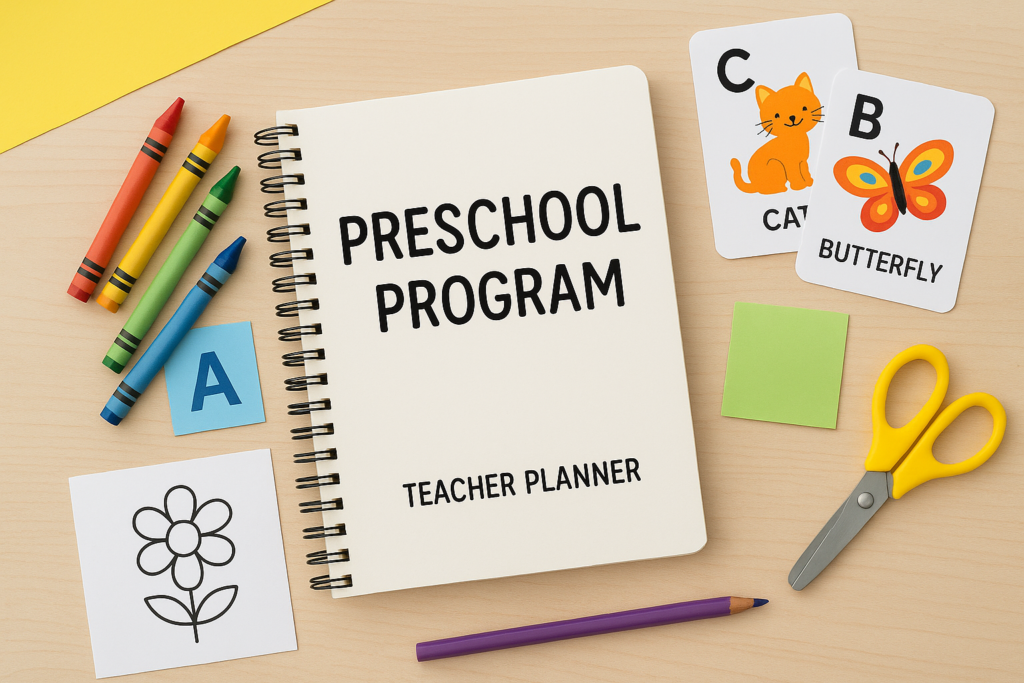Creating a preschool program is one of the most important parts of early childhood education. A well-designed program provides structure, creativity, and balance, helping children to explore, learn, and grow.
Whether you’re starting a new preschool, managing a classroom, or homeschooling. A thoughtful program ensures that learning goals, daily routines, and play activities work together to support whole-child development.
In this guide, we’ll walk you through the step-by-step process of designing a preschool program, from setting your philosophy and curriculum goals to organizing lessons, themes, and classroom routines.

Define Your Preschool Philosophy and Goals
Every preschool program starts with a clear educational philosophy.
Ask yourself:
- What kind of learning environment do you want to create?
- Your approach: Montessori, Reggio Emilia, or Play-Based?
- What values do you want to develop(curiosity, kindness, creativity)?
Your philosophy becomes the foundation of your design, daily schedule, and classroom interactions.
💡 Tip: You can read our related post on Play-Based Learning Benefits to help define your preschool’s learning approach.
Establish Learning Domains and Objectives
A balanced preschool program you can include learning goals that support all areas of early childhood development:
- Cognitive: Colors, shapes, sorting, problem-solving
- Language & Literacy: Storytelling, rhyming, letter recognition
- Math: Counting, patterns, spatial awareness
- Social & Emotional: Sharing, teamwork
- Physical: Cutting, running, jumping, balancing
- Creative Arts: Music, dance, painting, building
Write specific learning objectives for each domain. For example:
By the end of the year, children can identify the basic shapes and count 1 to 10.
Choose a Yearly Syllabus Framework
Now you know your goals, decide how to organize the yearly plan of your preschool program.
You can structure your syllabus by:
- Monthly Themes: (e.g., Seasons, Animals, Family, Community Helpers)
- Developmental Milestones: Focused on skills that progress over time
- Integrated Learning: Combining multiple subjects in one activity (e.g., counting during art or science play)
Example of yearly theme plan:
| Month | Theme | Core Skills |
|---|---|---|
| September | All About Me | Identity, Emotions |
| October | Fall & Nature | Observation, Art |
| November | Helpers | Community Awareness |
| December | Holidays & Giving | Social Skills |
| January | Winter | Science, Seasons |
| February | Friendship | Empathy, Communication |
| March | Animals | Nature Study |
| April | Plants & Growth | Observation |
| May | Ocean Life | Curiosity |
| June | Summer Fun | Outdoor Exploration |
Plan Weekly and Daily Routines
A good preschool program balances structured learning with free play.
A predictable rhythm helps children thrive. Their days should mix active, quiet, and creative times.
Example Daily Schedule:
| Time | Activity |
|---|---|
| 8:30–9:00 | Arrival & Free Play |
| 9:00–9:30 | Circle Time (Songs, Story, Calendar) |
| 9:30–10:15 | Learning Centers (Math, Art, Literacy) |
| 10:15–10:45 | Snack & Outdoor Play |
| 11:00–11:30 | Themed Lesson or Craft |
| 11:30–12:00 | Story Time & Goodbye Circle |
Develop Lessons and Activities
Themes bring your preschool program to life.
They connect academic skills with real-world experiences, making learning fun and memorable.
For each theme, include:
- Storybooks (related to the topic)
- Arts & Crafts (hands-on projects)
- Music & Movement (songs, dances)
- Science & Nature Play (simple experiments)
- Outdoor Activities (gross motor skills)
Example:
Theme: Spring and Growth
- Read The Tiny Seed by Eric Carle
- Plant bean seeds and track their growth
- Create flower crafts using tissue paper
- Sing “Grow, Grow, Grow!” during circle time
Organize Classroom Setup and Materials
Your environment plays a very important role in learning. A well-organized preschool classroom encourages independence and creativity.
Key zones to include:
- Reading Corner: Books and storytelling props
- Art Station: Paints, crayons, paper, and aprons
- Sensory Table: Sand, water, or rice bins
- Block Area: Building materials for STEM play
- Quiet Space: Cozy corner for relaxation
Label shelves and rotate materials monthly based on your theme. This keeps children curious and reduces clutter.
Evaluate and Improve Your Program
A preschool program should develop over time. Regular reflection helps you see what’s working and what needs adjusting.
Ways to evaluate:
- Observe student engagement and progress
- Get feedback from parents and co-teachers
- Review if your goals are being met
- Refresh activities to keep them relevant

